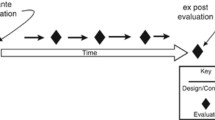Abstract
Many automatic graph layout algorithms have been designed and implemented to display relational data in a graphical (usually node-arc) manner. The success of these algorithms is typically measured by their computational efficiency and the extent to which they conform to aesthetic criteria (for example, minimising the number of crossings, maximising symmetry). Little research has been performed on the usability aspects of such algorithms: do they produce graph drawings that make the embodied information easy to use and understand? Is the computational effort expended on conforming to the assumed aesthetic criteria justifiable with respect to better usability? This paper reports on usability studies that were performed to investigate the merit of automatic graph layout algorithms with respect to human use. The paper describes three ways in which this issue has been considered experimentally: first, investigating individual aesthetic criteria in simple, abstract graph structures; second, investigating the results of common automatic graph layout algorithms; and third, investigating individual aesthetic criteria and other relevant secondary notations in Unified Modeling Language class and collaboration diagrams. The results show that the use of only some aesthetics affect usability significantly, and that the semantic domain of the graph drawings affects which aesthetic criteria need to be emphasised.
Similar content being viewed by others
References
Booch, G., Rumbaugh, J., and Jacobson, I. 1998. The Unified Modeling Language User Guide. Addison-Wesley.
Chrobak, M., and Payne, T. H. 1990. A linear time algorithm for drawing a planar graph on a grid. Technical Report UCR-CS-90-2, Department of Mathematics and Computer Science University California Riverside.
Coleman, M. K., and Stott Parker, D. 1996. Aesthetics-based graph layout for human consumption. Software—Practice and Experience 26(12): 1415–1438.
de Fraysseix, H., Pach, J., and Pollack, R. 1990. How to draw a planar graph on a grid. Combinatorica 10: 41–51.
Di Battista, G., Eades, P., Tamassia, R., and Tollis, I. 1994. Algorithms for drawing graphs. An annotated bibliography. Computational Geometry: Theory and Applications 4: 235–282.
Eades, P. 1982. A heuristic for graph drawing. Congressus Numeraturm 42: 149–160.
Fruchterman, T., and Reingold, E. 1991. Graph drawing by force-directed placement. Software—Practice and Experience 21(11): 1129–1164.
Gransner, E. R., and North, S. C. 1998. Improved force-directed layouts. In: S. H. Whitesides (ed.): Proceedings of Graph Drawing Symposium 1998. Lecture Notes in Computer Science, Montreal, Canada: Springer-Verlag, Vol. 1547, pp. 364–373.
Gottsdanker, R., 1978. Experimenting in Psychology. Prentice-Hall.
Gutwenger, C., and Mutzel, P. 1998. Planar polyline drawings with good angular resolution. In: S. H. Whitesides (ed.): Proceedings of Graph Drawing Symposium 1998, Lecture Notes in Computer Science, vol. 1547, Montreal, Canada: Springer-Verlag, pp. 167–182.
Himsolt, M., 1990. GRAPHEd User Manual. Universität Passau.
Himsolt, M., 1997. Personal Communication.
Kamada, T., and Kawai, S. 1989. An algorithm for drawing general undirected graphs. Information Processing Letters 31: 7–15.
Papakostas, A., and Tollis, I. G. 2000. Efficient orthogonal drawings of high degree graphs. Algorithmica 26(1): 100–125.
Petre, M. 1995. Why looking isn't always seeing: Readership skills and graphical programming. CACM 38(6): 33–44.
Purchase, H. C. 1997. Which aesthetic has the greatest effect on human understanding? In: G. Di Battista (ed.): Proceedings of Graph Drawing Symposium 1997. LNCS, vol. 1353. Rome, Italy: Springer-Verlag, pp. 248–259.
Purchase, H. C. 1998. Performance of layout algorithms: Comprehension, not computation. Journal of Visual Languages and Computing 9: 647–657.
Purchase, H. C., and Leonard, D. 1996. Graph drawing aesthetic metrics. Technical Report 361. University of Queensland Department of Computer Science.
Reingold, E., and Tilford, J. 1981. Tidier drawing of trees. IEEE Transactions on Software Engineering SE-7(2): 223–228.
Seisenberger, K. 1991. Termgraph: Ein system zur zeichnerischen darstellung von structurierten agenten und petrinetzen. Technical report, University of Passau. Diploma Thesis.
Tamassia, R. 1987. On embedding a graph in the grid with the minimum number of bends. SIAM Journal of Computing 16(3): 421–444.
Tunkelang, D. 1992. A practical approach to drawing undirected graphs. Technical report, Carnegie Mellon School of Computer Science. Technical Report CMU-CS-94-161.
Woods, D. 1982. Drawing Planar Graphs. PhD thesis, Department of Computer Science, Stanford University. Technical Report STAN-CS-82-943.
Author information
Authors and Affiliations
Rights and permissions
About this article
Cite this article
Purchase, H.C., Carrington, D. & Allder, JA. Empirical Evaluation of Aesthetics-based Graph Layout. Empirical Software Engineering 7, 233–255 (2002). https://doi.org/10.1023/A:1016344215610
Issue Date:
DOI: https://doi.org/10.1023/A:1016344215610




